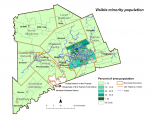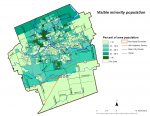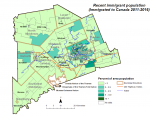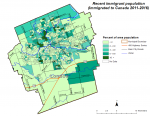Visible Minority and Immigrant Populations
Visible Minority and Immigrant Populations
The visible minority population of Middlesex-London included 76,460 people or 17.0% of the total population in 2016. This was much lower than Ontario overall (29.3%) (Figure 1.7.1).
The five visible minority groups with the largest populations in Middlesex-London in order of size were: Arab, South Asian, Black, Chinese, Latin American. Middlesex-London had a higher percent of the population identifying themselves as Arab and Latin American than the province overall (Figure 1.7.1).
The proportion of people identifying themselves as a visible minority increased since 1996 in Middlesex-London, although at a lower rate of change than Ontario overall (Figure 1.7.2)
Immigrants in Middlesex-London made up 20.3% of the population in 2016, similar to the 19.4% in 20111, but much lower compared to 29.1% in Ontario in 2016 (Figure 1.7.3).
The percent of recent immigrants (those who arrived between 2011 to 2016) as a percent of all immigrants (12.9%) in Middlesex-London was similar compared to Ontario (12.3%). More immigrants in Middlesex-London reported coming to Canada in the previous five years than in any other five-year interval (Figure 1.7.3).
Almost two-thirds of immigrants in Middlesex-London have been in Canada for more than 15 years (65.3%) compared to 62.9% in Ontario (Figure 1.7.3).
Maps (Figures 1.7.4 and 1.7.5) show how the percent of the visible minority population varies within the City of London and County of Middlesex. Within the City of London, there are specific areas where a higher concentration of people who are visible minorities live. These areas include West London/ Medway, Oakridge and White Oaks. Figures 1.7.6 and 1.7.7 show how the percent of people who recently immigrated to Canada between 2001 and 2006 vary within the City of London and County of Middlesex. Recent immigrants are also more concentrated within the City of London, however, there are some notable areas of concentration outside the City.
Interpretive notes:
In general, the health of immigrants tends to be better than that of the overall population.2 This is largely due to the fact that immigrants must generally be healthy to immigrate and often have better diets and health behaviours initially than the Ontario population. However, the “healthy immigrant effect” varies across the life-course and resettlement may create vulnerabilities that may require tailored public health services to reduce health risks and promote well-being.
Ontario Public Health Standards: Requirements for Programs, Services, and Accountability
Population Health Assessment and Surveillance Protocol, 2018
References:
- Statistics Canada. Middlesex-London Health Unit, Ontario (Code 3544) (table). National Household Survey (NHS) Profile. 2011 National Household Survey. Statistics Canada Catalogue no. 99-004-XWE. Ottawa, ON: Statistics Canada.2013. [updated 2013 Sep 11; cited 2018 Dec 3]. Available from: https://www12.statcan.gc.ca
- Vang Z, Sigouin J, Flenon A, Gagnon A. The Healthy Immigrant Effect in Canada: A Systematic Review, Population Change and Lifecourse Strategic Knowledge Cluster Discussion Paper Series. [Internet] 2015 [cited 2018 Dec 3]; 3(1) 4, Available from: https://ir.lib.uwo.ca/pclc/vol3/iss1/4
Last modified on: January 25, 2019
Jargon Explained
Visible minority
Visible minority refers to whether a person belongs to a visible minority group as defined by the Employment Equity Act,1995, and, if so, the visible minority group to which the person belongs. The Employment Equity Act defines visible minorities as "persons, other than Aboriginal peoples who are… non-white in colour."
Immigrant
Immigrants are people who are or who have ever been landed immigrants or permanent residents. Such persons have been granted the right to live in Canada permanently by immigration authorities. Immigrants who have obtained Canadian citizenship by naturalization are included in this category.
Non-permanent residents
Non-permanent residents are people from another country who have a work or study permit or who are refugee claimants, and their family members sharing the same permit and living in Canada with them. They are not considered immigrants.






